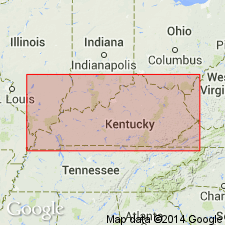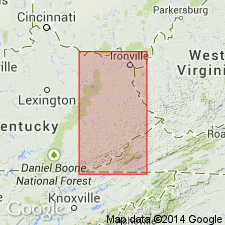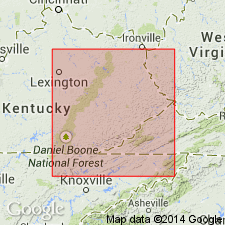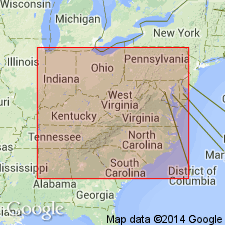
- Usage in publication:
-
- Crummies shale member
- Modifications:
-
- Informally named
- AAPG geologic province:
-
- Appalachian basin
Summary:
Breathitt Formation is informally elevated to group rank and subdivided into the following eight informal formations: Pocahontas, Bottom Creek, Alvy Creek, Grundy, Pikeville, Hyden, Four Corners, and Princess formations. Crummies shale member, informally used in this report, is assigned to the Pikeville formation. Overlies the Lower Elkhorn coal bed and underlies the Upper Elkhorn No. 1 coal bed. According to Fig. 1, the Crummies is assigned a Morrowan (Early Pennsylvanian) age. [Revisions made in this paper are strongly contested by C. Rice and other USGS scientists who work in this area (oral commun., 9/3/93).]
Source: GNU records (USGS DDS-6; Reston GNULEX).

- Usage in publication:
-
- Crummies Member*
- Modifications:
-
- Areal extent
- AAPG geologic province:
-
- Appalachian basin
Summary:
Crummies Member of Breathitt Formation. (= Cannelton Limestone of White, 1885.) Marine unit in lower part of Breathitt Formation below Elkins Fork shale (informal, unranked) or, where absent, Kendrick Shale Member. Lies above Betsie Shale Member (previously thought to = Cannelton Limestone of White, 1885). Lies below "A", Grassy, Harlan, Hopewell, Huckleberry, Jellico, Lacey Creek, Moss, No. 4, Rim, Upper Elkhorn No. 1, or Upper Elkhorn No. 2 coals; lies above Blue Gem, Bruin, Imboden, Lower Elkhorn, Path Fork, Pond Creek, Straight Creek, Vires, or Wolf Creek coals. Age is Middle Pennsylvanian.
Source: Publication.

- Usage in publication:
-
- Crummies Member*
- Modifications:
-
- Original reference
- Dominant lithology:
-
- Shale
- Siltstone
- Limestone
- Sandstone
- AAPG geologic province:
-
- Appalachian basin
Summary:
See also Rice and others, p. 115-155, this vol. Crummies Member of Breathitt Formation. Replaces what has been commonly misidentified as Campbell Creek Limestone of White (1885) in eastern Kentucky and adjacent parts of West Virginia and Virginia. Consists of upward-coarsening shale, siltstone, limestone, and sandstone in interbedded sets of sandstone and siltstone or siltstone and shale, with thin limestone beds. Thickness 109 feet at type section; ranges up to 140 feet. Overlies Path Fork coal bed; disconformably underlies a coal bed, or more commonly, a channel-fill sandstone. (= Cannelton Limestone of White, 1885 [now informal Cannelton limestone] in Kanawha River area of West Virginia.) Age is Middle Pennsylvanian.
In eastern KY, occurs in three belts: (1) along Cumberland overthrust sheet; (2) a belt extending from KY into equivalent units in VA into WV, and (3) a belt bordering Cumberland Escarpment along northwest edge of eastern KY coal field. Inlier found near Redbush, KY. Fig. 1 also shows Crummies extending southward to meet with equivalent rocks in TN.
Type section: 138-ft section on U.S. Highway 421, about 1,500 ft (450 m) east of the village of Crummies, Harlan Co., eastern KY.
Source: Modified from GNU records (USGS DDS-6; Reston GNULEX).

- Usage in publication:
-
- Crummies Member
- Modifications:
-
- Areal extent
- AAPG geologic province:
-
- Appalachian basin
Summary:
Corr. chart. Crummies Member of Pikeville Formation of Breathitt Group (KY); Crummies Member of Kanawha Formation of Pottsville Group (WV). Shale and/or mudstone. In eastern and southeastern Kentucky is a member of Pikeville Formation; lies below the Upper Elkhorn No. 1 coal and above the Lower Elkhorn (Pond Creek, Blue Gem, Eagle) coal zone. In West Virginia is a member of Kanawha Formation of Pottsville Group; lies below the Powellton coal zone and above the Eagle coal zone. Equivalent to an unnamed marine shale in Wise Formation of southwestern Virginia, between the Upper St. Charles and Kelly coal beds. Carries marine fossils. Age is early Middle Pennsylvanian (Westphalian; early Atokan). [Peppers (1996, GSA Memoir 188, pl.) placed the Pond Creek and Eagle coals in Westphalian B, MICRORETICULATISPORITES NOBILIS-FLORINITES JUNIOR (NJ) miospore assemblage zone of western Europe.]
[See also Chesnut, 1997 (revised Oct. 12, 1999), Stratigraphy of the coal-bearing strata of the Eastern Kentucky coal field, available online through the Kentucky Geol. Survey (http://www.uky.edu/KGS/coal/coalcorrel.htm).]
Source: Publication.
For more information, please contact Nancy Stamm, Geologic Names Committee Secretary.
Asterisk (*) indicates published by U.S. Geological Survey authors.
"No current usage" (†) implies that a name has been abandoned or has fallen into disuse. Former usage and, if known, replacement name given in parentheses ( ).
Slash (/) indicates name conflicts with nomenclatural guidelines (CSN, 1933; ACSN, 1961, 1970; NACSN, 1983, 2005, 2021). May be explained within brackets ([ ]).

